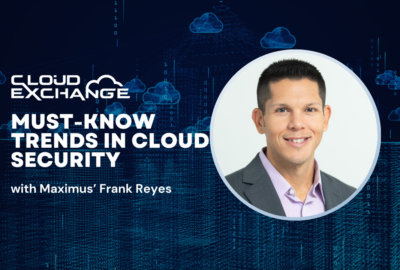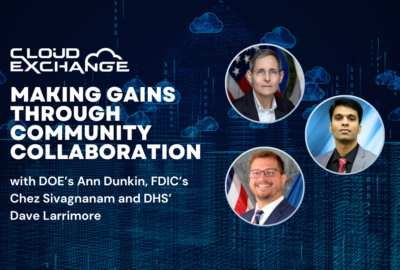Insight by Maximus
Cloud Exchange 2024: Maximus’ Frank Reyes on leveraging generative AI, FinOps
The Maximus cloud expert offers how to use FinOps to manage cloud costs not stymie innovation.
Many federal agencies have the itch to experiment with generative artificial intelligence (AI) in the cloud. But emerging technologies, combined with the rise of new cloud features and applications, can bring sticker shock.
Frank Reyes, managing director for software and infrastructure capabilities at Maximus, said agencies are looking at how to get the most out of their cloud spend and avoid IT bloat and waste.
This heralds a new era of cloud modernization, he added.
“Agencies are starting to look at how to optimize performance, realizing that their cloud spend is becoming disproportionately larger than they had anticipated,” Reyes said during Federal News Network’s Cloud Exchange 2024.
The ease of setting up cloud workloads has led to “cloud sprawl — having resources in the cloud that have been abandoned by people forgetting about it,” he said. So a cleanup presents one way to reduce cloud costs. Reyes added that in the precloud days, the costs and sheer work of budgeting for, acquiring and setting up physical servers served as a guardrail against runaway costs.
Now, he said, “we’re definitely seeing cloud program management offices starting to create some of these guardrails for their developers.”
What’s driving cost of generative AI in the cloud?
The major commercial cloud platform providers — Amazon Web Services, Google and Microsoft — have made large investments in AI, including generative AI services. Simply offering these services raised the companies’ costs, Reyes said.
“The underlying hardware for [AI is] very expensive,” he said. “We’ve all heard the earnings calls from the major hardware vendors who provide much of this AI technology on the back end. That translates to the services being more costly than just running a normal compute workload.”
Reyes said spend management for AI won’t necessarily relate to data ingest and egress costs. Just as cell phone minutes eventually became commoditized, so too have cloud data charges.
Therefore, to optimize cloud costs, Reyes suggested agencies take a financial operations, or FinOps, approach. He noted the establishment of the nonprofit FinOps Foundation dedicated to helping organizations develop cloud optimization skills.
Under the FinOps model, agencies can determine the right balance between having guardrails but not unduly restricting developers. The question for IT staffs, he said, becomes, “How do I make design choices from the architecture, development and operations point of view using the cost of my IT spend as part of a design constraint?”
Exposing developers to cloud costs will help them make more informed decisions, Reyes added, rather than simply scaling up more cloud capacity.
“The cost of infrastructure was blind to them,” Reyes said.
How does FinOps help manage cloud costs?
Instead, an agency should bring cost insight back to the application developers so they can make intelligent tradeoffs among features, performance and costs of running applications. When everyone is operating in a FinOps mode, Reyes said, the agency can avoid underinnovating or not doing promising projects just because people aren’t sure of what cloud charges will run.
FinOps becomes especially important, he said, as cloud adoption leads agencies to working more in an operational expense mode rather than the capital expense one they used for operating on-premise data centers and servers.
Reyes urged federal tech staffs to think in terms of value-oriented development. It derives from an architectural vision of the applications. For example, an agency might have a goal of increasing the speed of transactions while reducing the number of required touch points by users or the number forms they must submit.
Government may not have a purely financial incentive for reducing costs, but agencies are under obligation to improve customer experience, Reyes said. Either way, they need to understand the eventual cloud costs associated with that transaction initiative.
Whatever the goals for the system, “FinOps helps to bring that all together — that discipline and communicating that to the entire team,” Reyes said. He advised thinking about like this: Embedding cost considerations into cloud development is parallel to making cybersecurity part of everyone’s thinking.
Discover more articles and videos now on Federal News Network’s Cloud Exchange 2024 event page.
Copyright © 2025 Federal News Network. All rights reserved. This website is not intended for users located within the European Economic Area.
Tom Temin is host of the Federal Drive and has been providing insight on federal technology and management issues for more than 30 years.
Follow @tteminWFED






